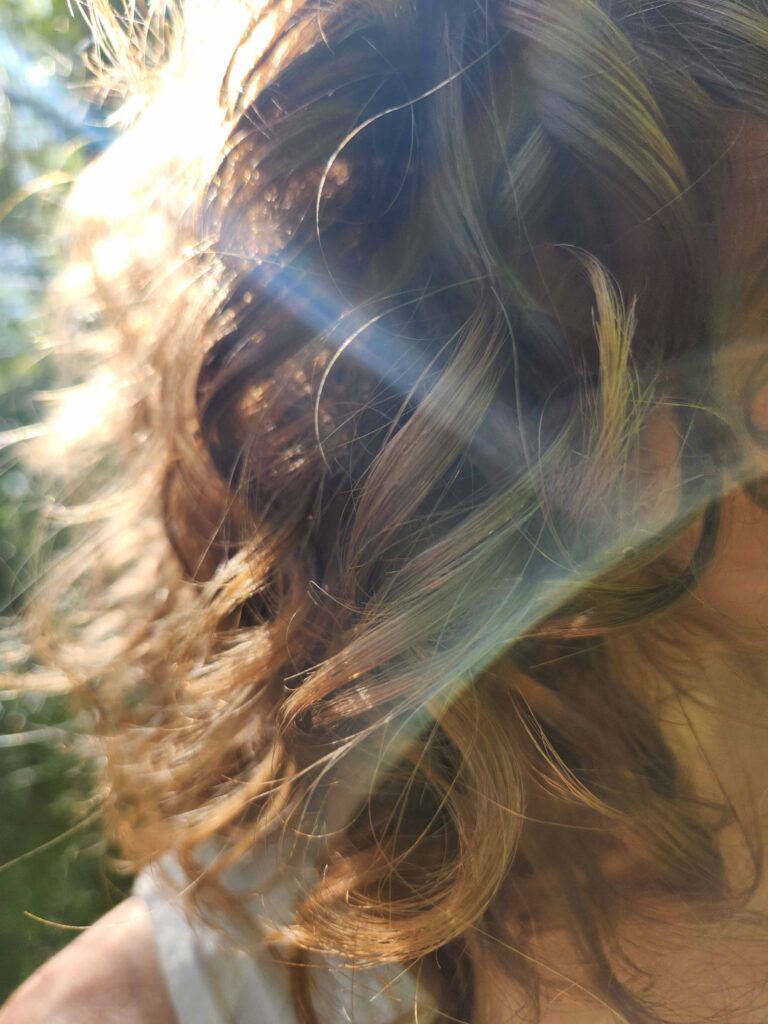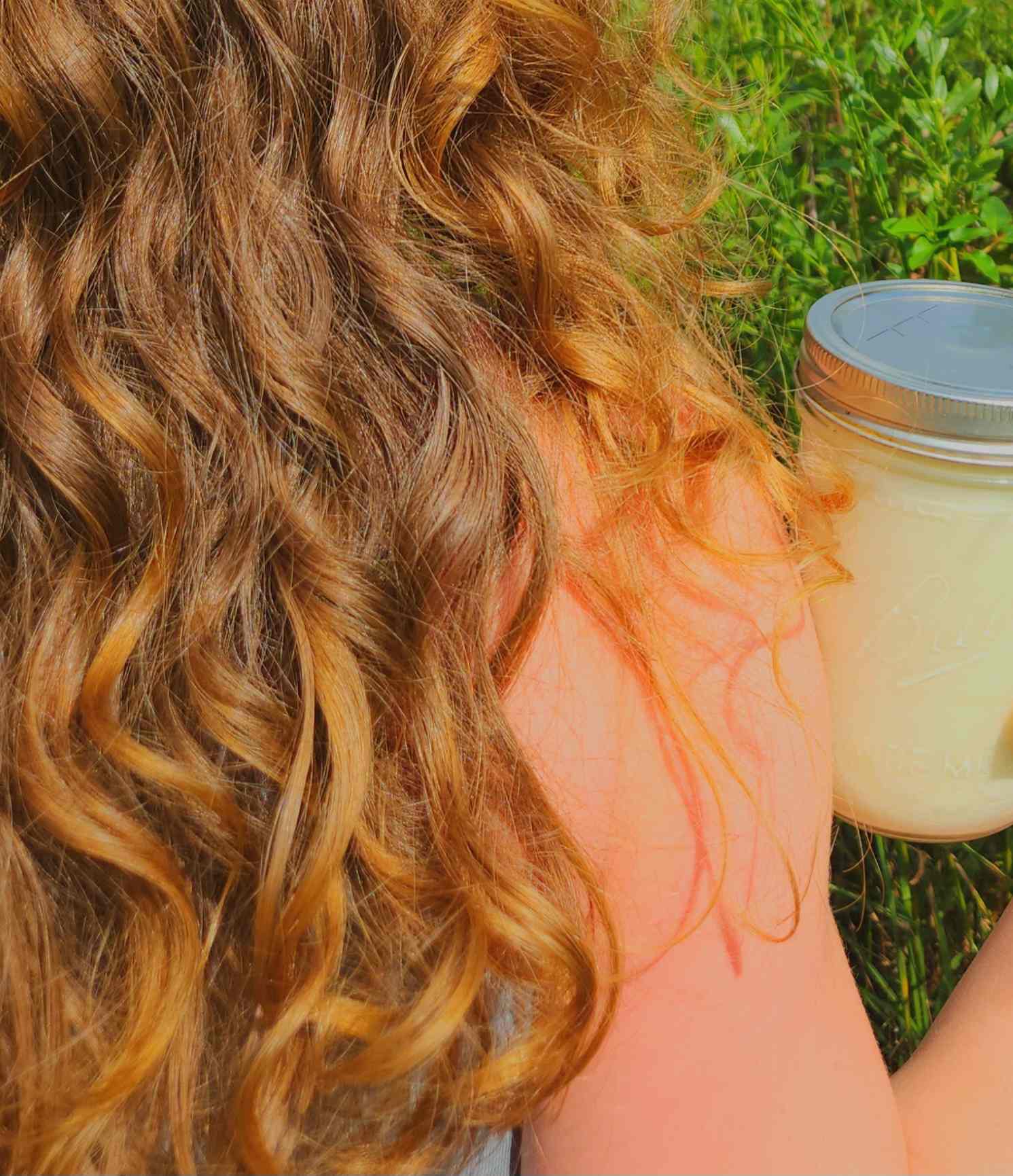Natural Hair Mask with Amazing Benefits: Bentonite Clay

This bentonite clay hair mask has so many benefits. Clay has been used for health and healing throughout history- and for good reason! Give your hair follicles a healthy detox with this natural bentonite clay hair mask recipe.
Natural hair care can be a challenge. If you are like me, you’ve tried nearly every natural shampoo and conditioner you could find. You’ve even gone “no-poo”.
Let me tell you something I’ve learned after the many years (and dollars) I spent hunting for the perfect natural shampoo and conditioner: the shampoo and conditioner doesn’t matter all that much when it comes to having silky, soft, clean, and light feeling healthy hair.
That’s right.
I have bought some really expensive natural hair products – still to end up with icky, heavy, frizzy hair (having curly hair doesn’t help…). Ultimately, a couple of simple additions to my hair care routine changed everything.
So what’s the secret?
The two things that turned my natural hair regimen upside down were…
Hair masks and hair rinses.
I now buy a very inexpensive type of all natural shampoo and conditioner, because I realized what I needed was to get the product buildup, dead skin cells, toxins and excess oil out, and to bring my hair back to an acidic state. Natural shampoo and conditioner just don’t do all that!
Since I have curly hair, I use a little natural leave-in conditioner. Before I used hair masks and hair rinses, the leave-in conditioner would just build up on top of everything else and become heavy and greasy. Somehow my hair would be heavy, greasy and frizzy all at the same time! But now when I apply my leave-in conditioner, I have better curl definition and the curls feel light and bouncy.
I give my hair a good wash about 2 times a week. Every time I wash my hair, I use hair rinses before and after conditioning.
You can give your hair a deep cleanse with this bentonite hair mask about every 6-8 weeks. If you keep your hair somewhat long, it’s recommended to get a hair trim about every 6-8 weeks. That being said, a good way to remember when you’re due for a hair mask is after every haircut! The clay can dry the hair out a little because it penetrates the hair follicle and soaks up natural oils along with the toxins, so I wouldn’t do it much more often than this.
Here are the kinds of hair masks and hair rinses I use:
Bentonite clay hair mask: detoxes and deep cleans the hair follicles by removing product buildup, environmental toxins, dead skin cells and excess sebum. Gives your hair a “clean slate”.
Acidic hair rinse: removes leftover product buildup, allows deep moisture to be sealed into hair follicles, brings the hair to an acidic pH which gives soft and shiny hair. See my acidic rinse recipe here.
What is Bentonite Clay?

Bentonite clay, also called montmorillonite clay, is a volcanic ash sediment that has a negative charge and very small particles. It’s named after a place called Fort Benton, where a lot of this volcanic ash product is found. Because of the negative charge and small particles of bentonite clay, it’s like a magnet for toxins, which usually have a positive charge. The very small particles make the clay like a sponge for excess oils and residue. There are many benefits of bentonite clay, from detoxing heavy metals to soothing bug bites. Native Americans called this clay “the mud that heals” or “ee wah kee”.
Bentonite clay contains minerals like calcium, magnesium, potassium, sodium and iron. Used as a face mask, it’s very helpful for acne prone skin or dry skin. After a bentonite clay treatment, my face feels so smooth and refreshed!
What about the use of bentonite clay on hair? In a study on sheep, the application of bentonite clay was shown to increase hair growth. There haven’t been scientific studies yet, but I bet it can do the same for human hair! For me, eliminating environmental toxins is very important. I think bentonite clay is the perfect product to do the job!
Clay has been used traditionally since ancient times externally as well as internally! It was used historically by Aborigines and South American natives. Native Americans baked clay with acorn flour to eliminate the toxins from the acorns. Aristotle suggested clay be ingested for medicinal reasons. Arabians around the 1200s were observed ingesting it for fevers, and pregnant women in varying parts of Africa to this day ingest small amounts which supplies them with calcium they need. All over the world clay was and is used on the body for healing wounds or aiding the skin.
*Before you go eating a bowl of clay, make sure you research this topic thoroughly and know what you’re doing. It can cause a blockage and have possible other side effects if ingested improperly!
Whether you have natural curls like me, or straight hair, thin hair, dry hair, oily hair…bentonite clay can be used for all hair types. A bentonite clay hair mask would be a great addition to your natural hair care routine!
Make sure you are using calcium bentonite clay, not sodium bentonite clay, for your hair.
About Oils
Many bentonite clay hair mask recipes include olive oil or coconut oil. Mine does not, and here’s why:
I used to coat my hair in oils – especially when I was following the “no-poo” method. Now that I discovered how important detoxing and bringing my hair back to an acidic pH is, I limit the amount of added oils I put in my hair. Adding a lot of oil, like olive oil and coconut oil, can actually weaken your hair and disturb the natural oils which can cause unhealthy hair and a variety of scalp conditions. It also can make it more difficult to get the toxins and build up out of your hair. I suggest sticking to a natural conditioner and a small amount of leave-in conditioner, instead of covering your hair with oil like I used to. I have had much healthier hair this way. A little oil isn’t bad, if you have dry ends you could add a tiny amount of jojoba oil to the ends. This is actually a wax ester and not technically an oil, and is similar in composition to natural sebum. It will be light and not as thick and sticky as olive oil or coconut oil.
Not to mention, it’s best to avoid seed oils as much as possible!
About Lead
When I was researching bentonite clay, I found that there are some concerns about lead. It turns out there are traces of lead in bentonite clay, just like there are traces found in plant foods and other natural products. The lead in bentonite clay is already “bound” so it’s not likely to be absorbed by the body. I don’t understand much about how the chemistry works, but I think Wellness Mama sums it up pretty well in this post. So I suggest doing your research and deciding whether you think the benefits outweigh the risks when using bentonite clay!
My Bentonite Hair Mask Routine

- Clean hair thoroughly with shampoo and rinse out.
- Pour bentonite clay mixture on hair and distribute through hair with a wide tooth comb, making sure to cover roots and ends of hair.
- Complete other shower tasks for 2-5 minutes while hair is covered in the clay ( I like to brush my teeth in the shower…)
- Gently rinse bentonite clay out of hair as much as possible.
- Shampoo hair a second time, to help remove bentonite clay.
- Cover hair with acid rinse, massage through hair and scalp, and rinse thoroughly.
- Apply conditioner to hair, massage through hair and scalp, and rinse thoroughly.
- If your hair still feels a little rough like there’s clay in it, do another round of conditioner and rinse out thoroughly.
- Cover hair with another round of acid rinse, and rinse thoroughly.
- Gently squeeze hair (if you have longer hair) and wrap in a cotton or hemp towel.
- Unwrap hair and style – using only natural products and low heat styling tools.
If it seems like all these steps are excessive – I’ve tried skipping a step here and there, and did not get the same results. So every step is important!
Tips and Tricks
- Make sure you are using warm water when rinsing clay out. The clay will not come out easily with cold water!
- The best way to be sure this recipe works for your is to try a patch test before trying it on all of your hair. Make sure to follow all steps even with just a small patch of hair.
- Make sure your shower water is filtered. It doesn’t make any sense to detox hair with toxic water! Plus, a lot of tap water has chlorine which dries out the hair and skin. If you have well or spring water, consider getting it tested – there can still be contaminants in well water.
- Make this recipe fresh for each use to get the most benefits.
- For the best results, follow all steps in order. The acidic hair rinsing is very important, don’t skip these steps!
Bentonite Clay Hair Mask Recipe
You will need:
1.5 Tablespoons Bentonite clay
1.5 Cups Filtered Water
That’s it!
Directions:
Before taking a shower, combine bentonite clay and water in a glass, ceramic cup, or wide mouth mason jar with a nonmetallic mixing utensil.
You now have your bentonite clay hair mask!
Now you can follow the hair mask routine steps.
Why does this recipe make such a thin hair mask product?
Bentonite clay can have a drying effect and can be difficult to wash out if the hair mask recipe is too thick. With this in mind, it’s best for the hair mask viscosity to be more of a liquid than a paste.
Just a heads up, your hair may feel more dry than usual after this hair mask routine because of everything that was pulled out. After another wash or two it should feel back to normal. Leave-in conditioner always helps me!
What is your favorite way to use bentonite clay? Let me know in the comments!
*This is not medical advice
*None of these statements have been evaluated by the FDA
Shop This Post
My favorite bentonite clay
*As an Amazon associate, I earn from qualifying purchases
Sources
wellnessmama.com/natural-home/lead-in-bentonite-clay (Link)
enviromedica.com/blogs/learn/eating-clay-lessons-on-medicine-from-worldwide-cultures (Link)
ncbi.nlm.nih.gov/pmc/articles/PMC5632318 (Link)
www.localharvest.org/blog/25051/entry/medicinal_clay_bentonite. (Link)






